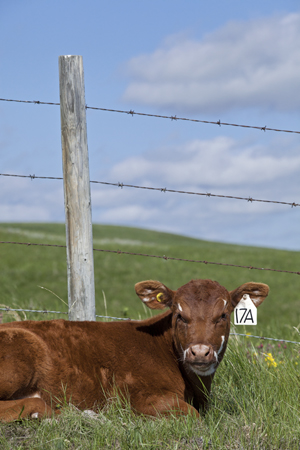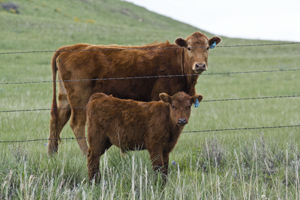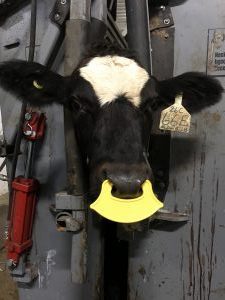Low-stress weaning benefits on several levels
Editor’s note: The following is the first in a two-part series on low stress weaning. In part two, you’ll hear directly from producers with large herds that use these methods.

There is way more to it than just going to bed with a yard full of quiet cattle, but that’s one of the notable spinoff benefits cow-calf producers from across Canada attribute to low-stress weaning systems they’ve used for several years.
Producers say calves that are eased into weaning perform better immediately after weaning, they observe considerably fewer cases of stress-related diseases, the anxiety and stress demonstrated by both cows and calves during the more traditional abrupt or cold weaning is virtually eliminated, and yes the farm yard is much quieter, too.

There are two fairly common approaches to low-stress weaning. One is called fenceline weaning that involves sorting cow-calf pairs on weaning day and keeping them separated by a fenceline that allows mothers and calves to see each other but calves can’t nurse. After two or three days everyone contentedly walks away from the fence.
The other, a two-stage weaning system — commercially known as QuietWean —involves a non-surgical procedure of inserting or clipping a plastic nose flap inside the nostrils of calves a few days before the actual “weaning day”. Once the flaps are in, cow-calf pairs remain together out on pasture (or in some cases even in a drylot) but the flaps prevent calves from nursing. After about five or six days, the nose flaps are removed, the cow-calf pairs are separated, and both cows and calves go their separate ways, quietly with little apparent anxiety of being separated.

While there are a few pros and cons with both lower-stress weaning systems, Derek Haley, PhD, a researcher in animal welfare and behaviour at the University of Guelph’s Ontario Veterinary College, says the benefits of easing both calves and cows toward weaning are clear from an animal welfare perspective, and both research and anecdotal information suggest improved performance features as well.
Haley, who did his doctoral research work at the University of Saskatchewan, was at the centre of research which more or less accidentally discovered the concept for the QuietWean system nearly 20 years ago. His research looked at the stress associated with weaning calves.
“The question we were really trying to answer was what does a calf miss most at weaning,” says Haley. “Do they miss their mother or do the miss the milk? There were varying views on the question.”

So working alongside Joe Stookey, PhD, a long-time animal welfare specialist at the U of S (now retired) they came up with a project to test the question. The project relied on the long-established idea of using an anti-sucking device such as a nose flap to prevent calves from nursing. The flaps were attached to a group of research calves that were turned back out with their mothers.
“In observing these calves for three or fours days we discovered they really didn’t show many signs of distress when they weren’t able to nurse,” says Haley. So then after three or four days they took those calves away from the mothers, to answer the second part of the question – how much the calves missed their mothers. “Again we observed that these calves that wore nose flaps, showed hardly any visible signs of distress in being separated from their mothers. Somewhat to our surprise we had just wiped out the behavioural signs of distress at weaning. So then we thought this method of weaning not only helped us answer our research question, but perhaps it had a broader application for beef producers.” The nose flap concept was eventually sold and commercialized and is now marketed as the QuietWean system.

Haley says there is no doubt two-stage weaning eliminates or at least dramatically reduces the anxiety and stress associated with cold weaning — and the stress is significant. “There is no other procedure we do to beef cattle that shows a behavioural response lasting for four days,” says Haley. And he believes reducing stress in calves translates into production benefits.
As a follow up to the first research showing behavioural benefits of two-stage weaning, they also conducted feeding studies observing calves immediately after weaning. Again the evidence was clear — calves that had been weaned in two stages quickly and easily moved onto a post-weaning ration without missing a beat. Calves that were abruptly cold weaned did not eat for several days as they continued to pace and bawl for their mothers.
“Calves that were weaned in two stages had improved weight gain immediately after weaning compared to calves that were abruptly weaned,” he says. “They ate well, their stomachs were full, which would hopefully mean a smooth transition into the rest of their feeding program.”
He says there is conflicting research on how long that weight gain benefit lasts. Some studies show some calves maintain that weight advantage through to the finishing feedlot, while other studies show that after about a month the abruptly weaned calves catch up. More research is needed. More research is also needed to determine whether two-stage weaning reduces stress enough to make the vaccines administered at weaning more effective.

Haley says it is generally considered that calves weaned through two-stage weaning have improved health status in the backgrounding feedlot. “I have heard those anecdotal reports many times from producers and I have no reason to doubt it,” he says. “But it is something that needs to be properly confirmed with research. It makes sense if those calves weaned in two stages had less stress and immediately went on feed that the risk of developing respiratory diseases, for example, would be reduced. But it needs to be properly evaluated in a study over a large number of calves, from different ranches, with half weaned in two stages and half weaned abruptly and that hasn’t been done.”
He says it is just one of several questions still to be answered as research funding becomes available. Both low-stress weaning systems can be effective in reducing calf stress at weaning. With fenceline weaning, however, the fence does have to be in good shape to reduce the risk of cows or calves breaking through. With two-stage weaning, the main downside people cited — calves have to be handled twice with some degree of proper restraint. First they need to be restrained to clip the nose flaps in place and a few days later (4 days minimum, 7 days maximum) the clips have to be removed. That’s less stress than abrupt weaning, but not stress free.
Currently Haley is working on a project, funded in part by Beef Farmers of Ontario. It’s looking at measures, which might further optimize benefits of two-stage weaning by supplying calves with creep feed two to three weeks before they are weaned. Preliminary results are leaning toward benefits, but the research is ongoing.
“Using two-stage weaning to reduce stress in cattle is certainly good news for the beef industry as it demonstrates its commitment to improve animal welfare to consumers,” he says. There is also good evidence the practice shows improved production benefits, but the answers to some questions still need to be confirmed.
Editor’s note: See part two of this two-part series featuring producers using these methods in large herds.
Click here to subscribe to the BCRC Blog and receive email notifications when new content is posted.
The sharing or reprinting of BCRC Blog articles is welcome and encouraged. Please provide acknowledgement to the Beef Cattle Research Council, list the website address, www.BeefResearch.ca, and let us know you chose to share the article by emailing us at info@beefresearch.ca.
We welcome your questions, comments and suggestions. Contact us directly or generate public discussion by posting your thoughts below.